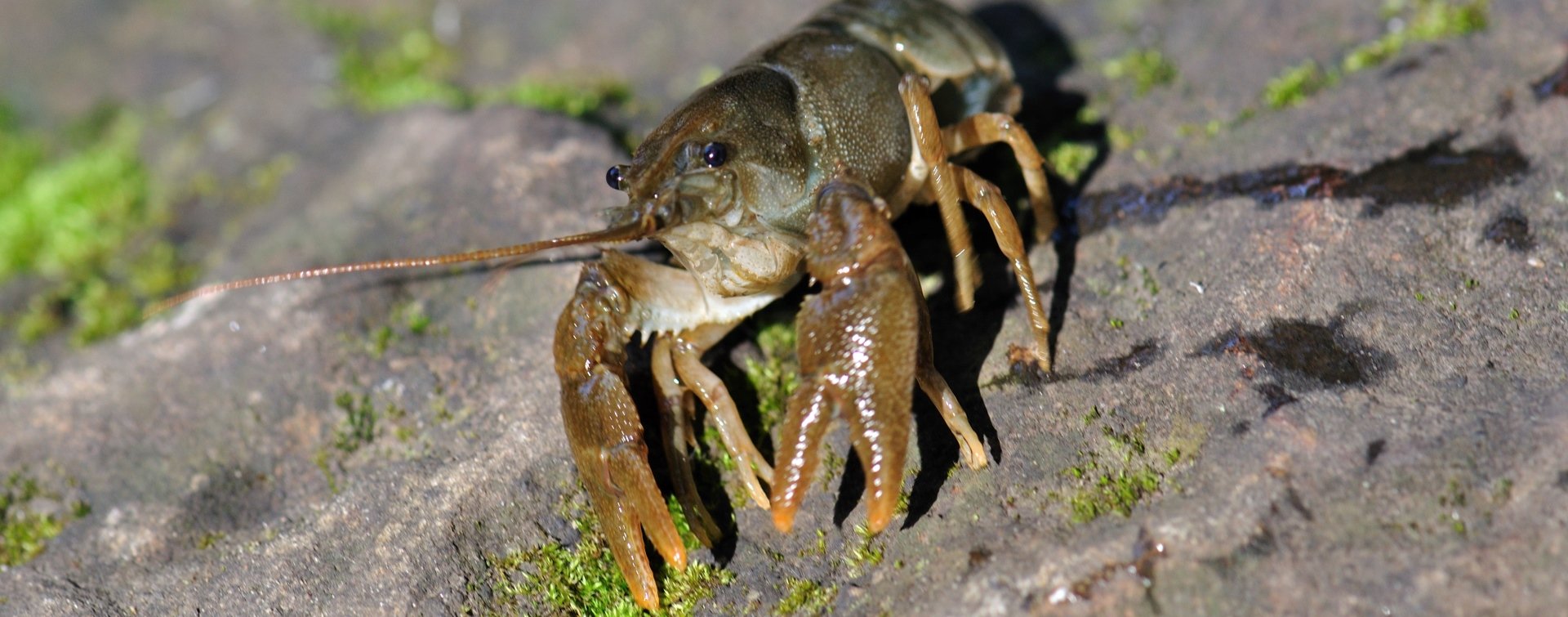
Background
The white-clawed crayfish is Britain’s only native species of crayfish. It will occupy a variety of habitats including streams, rivers, brooks, reservoirs and water-filled quarries. Although abundant in some waterbodies, the white-clawed crayfish has seen a dramatic decline in population in recent decades, primarily due to the presence of non-native species, including the North American signal crayfish that can carry a disease known as ‘crayfish plague’.
Due to the decline in white-clawed crayfish numbers, it is now listed on Schedule 5 of the Wildlife and Countryside Act 1981 (as amended) and is also included in Appendix III of the Bern Convention and Annexes II and V of the European Habitats and Species Directive. It is also a Priority Species under the UK Post-2010 Biodiversity Framework. Therefore, if development works are proposed within, or in close proximity to a suitable waterbody, it is important to determine if white-clawed crayfish are present and whether the proposed works will impact on the species.
Timing
White-clawed crayfish surveys can be carried out between July and September inclusively. A torchlight survey may be undertaken between April and June; however, other survey techniques are not advised during this period as it is likely to cause harm to the juvenile crayfish.
Methodology
Depending on the nature of the site and its location, the local biological record centre may initially be contacted to see if there are records of crayfish within the waterbody that may be impacted by the works. Even when there are records of white-clawed crayfish in a watercourse, they are not uniformly spread along the channel and therefore a survey of crayfish presence and population must be conducted on site by a suitably qualified ecologist with an appropriate Natural England crayfish licence. There are a number of survey methods that may be used as appropriate:
Refuge Sampling
The standard survey method used to search for crayfish along a watercourse involves selectively searching potential refuges at a sample location within the water body and completing a habitat assessment. Several sample locations may be required to establish a population estimate (although normally the primary purpose of the survey is to establish presence or presumed absence). Where appropriate, kick sampling using a pond net is also used.
Night Viewing
This method involves recording crayfish via torchlight at night. This method results in minimal disturbance to the watercourse, covers a wider area and also covers inaccessible areas compared to manual searches such as refuge sampling.
Crayfish Trapping
A passive method using baited traps that are left in situ for no longer than 24 hours at a time. Traps are set in the evening and then retrieved the following morning and any captured white-clawed crayfish are released. This method requires consent from the Environment Agency. Only ‘otter friendly’ traps are used.
To request a more detailed white clawed crayfish survey information sheet, please email mail@emec-ecology.co.uk.
Following the Survey
Report
We will provide a report detailing the results of our survey and any required mitigation as soon as possible following the survey, however; should you have a specific date for submission of a planning application we will do our utmost to accommodate this.
Licensing and Mitigation
Should white-clawed crayfish be present within or in close proximity to a development site, where it is likely that the crayfish will be either disturbed, injured or killed by the proposed works, it may be necessary to translocate the crayfish i.e. moving the white-clawed crayfish from the area to be affected into safe areas of suitable habitat. This will require a conservation licence from Natural England that will require detailed mitigation, compensation and enhancement measures to ensure no adverse impacts to this declining species.
Should a licence be required, EMEC Ecology can apply for this on a client’s behalf. EMEC Ecology has the ability to design and implement site-specific mitigation, compensation and enhancement measures that will be suitable for a planning application.
Monitoring
Monitoring the impact of development works is an important part of conservation and should it be required (it is often a stipulation of a licence), EMEC Ecology can monitor the site to see how effective the mitigation has been.
Examples
White-clawed Crayfish Survey near Nottingham
Initial survey work at the site revealed the presence of a healthy population of native crayfish and no invasive crayfish species. As the development works would affect the crayfish, EMEC Ecology produced a mitigation strategy for the site, under a conservation licence from Natural England, for the site. Over one hundred white-clawed crayfish were excluded from a target area and translocated to a suitable receptor site prior to the development works. While high risk elements of the works were carried out EMEC Ecology worked closely with the contractors as Ecological Clerk of Works. In conjunction with the translocation of white-clawed crayfish, this project involved the creation and enhancement of suitable crayfish habitat. EMEC Ecology then carried out monitoring over the following two years to determine the success of the scheme.
Request a quote
EMEC Ecology provides White Clawed Crayfish Surveys throughout Nottinghamshire, Leicestershire, Derbyshire, Lincolnshire, the East Midlands and the rest of the UK. Each survey will be specific to a site and the costs will vary accordingly.
If you require a quotation please send an email to us at mail@emec-ecology.co.uk including any site plans that you have available (or details and photographs of the site if applicable) with details of the proposed works, along with your contact details. Should you wish to discuss your requirements further, please call us on 0115 964 4828.